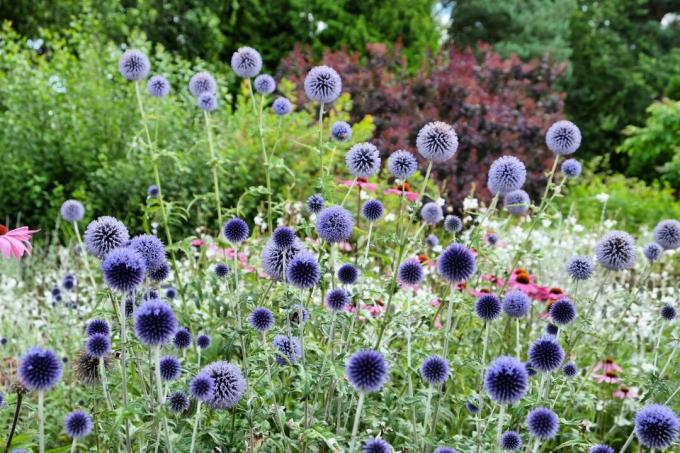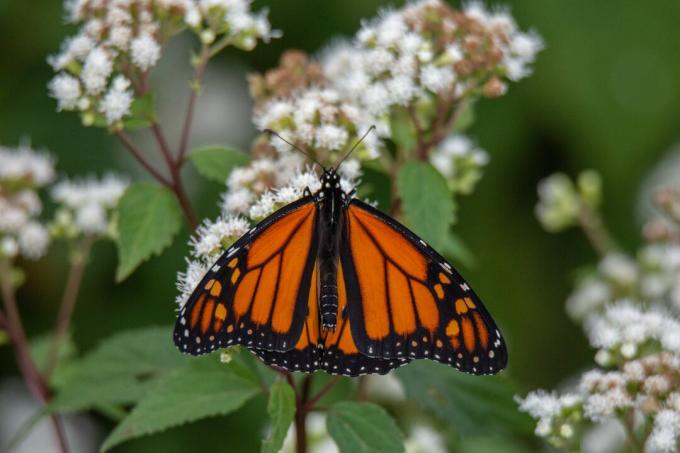Colorful perennials and autumn flowers replace the summer flowers after the warm seasonprovide insects with food again before winter. Discover with us the most beautiful autumn perennials in portrait.

The perennial autumn perennials are characterized by late flowering or show striking autumn colors in bright, cheerful colors. We present particularly attractive autumn perennials and their soil and care requirements.
contents
- leadwort
- chrysanthemums
- sedum
- heather
- Autumn Anemones
- Autumn Aster
- globe thistle
- lantern flower
- October silver candle
- coneflower
- water dost
leadwort
The leadwort (Ceratostigma plumbaginoides) brings a special play of colors into the garden. In autumn, the foliage of the perennial, hardy perennial turns wine-red. The flowers of the leadwort, on the other hand, shine in sky blue and form a colorful contrast. The flowering period is between August and October. The plants, which are up to 30 cm high, spread by runners and can form a pretty carpet of flowers over the years. The leadwort is best suited for permeable, rather barren, calcareous and dry soils in full sun. It can be placed in the rock garden, under tall trees or on sunny dry stone walls. Young plants are somewhat sensitive to frost in the first few years, which is why leadwort is planted in spring and should be given a layer of foliage as protection in severe winters.

chrysanthemums
Perennials are particularly colorful in autumn chrysanthemums (chrysanthemum) and thus compete with the most colorful autumn leaves. The potted chrysanthemum (Chrysanthemum frutescens) popular as a balcony plant. But it also brings color into the perennial bed in sunny and warm locations. But for the chrysanthemum to develop its full splendor, proper care is important: That's how it should be The plant should be watered daily on warm days, otherwise its large leaves will quickly droop down. After flowering, the plants are then cut back and the root balls protected from frost with leaves or fir branches. Potted chrysanthemums should be overwintered in a frost-free and cool place in the winter quarters or in a garden shed. In early summer, the chrysanthemum is happy about a little fertilizer and will reward you again in autumn with its beautiful bloom.

sedum
The name sedum (sedum) sounds anything but elegant and beautiful - but in reality the sedum plant is a real eye-catcher and survivor. With its numerous small flowers, which only unfold their full beauty as large flower plates in autumn, the sedum steals the show from many other plants. But that's not the only thing that makes the sedum perfect for the autumnal sea of flowers. Thanks to its ability to store water, the sedum plant is also very robust, insensitive to heat and frugal and thrives extremely well even with little care. In addition, a large number of varieties are perennial, hardy and embellish our beds for many years. The optimal location for the sedum is on dry, permeable and not too nutrient-rich soil in full sun.

heather
The heather family (Ericaceae) are robust, continuous bloomers, whether in winter, summer or autumn. The various types and varieties of the evergreen heather produce tiny, sometimes bell-shaped or bud-like flowers in various shades of white and pink. the heather (Calluna vulgaris) blooms from August into November, when temperatures drop and many summer flowers are already drooping. The special thing about it: some flowers remain in the bud stage and do not bloom. As a result, the small dabs of color cannot fade and are a real ray of hope even on cloudy days. The heather plants need acidic soil because they come from moor and peat areas. Because the garden soil in most areas is too chalky, it needs to be supplemented with an acidic substrate in order for ericaceous plants to thrive. Our Plantura Organic Acid Soil has a low pH between 4.6 and 5.4. It is therefore suitable for heather, but also for Rhododendrons (rhododendron) and blueberries (Vaccinium).

Autumn Anemones
Filigree and beautiful: The Autumn Anemone (Anemone hupehensis) is simply a must among the hardy fall perennials. Its large, eye-catching flowers shine in white, pink or red tones from July to October. The fluffy, white infructescences that many varieties form in autumn are also extremely decorative. In contrast to many other autumn plants, the autumn anemones prefer a partially shaded location, but also thrive in full sun. Above all, an adequate supply of water and very humus-rich soil are important for them. Waterlogging must be avoided at all costs. Otherwise, the autumn anemones are quite robust. When it comes to growth, the autumn anemone is quite slow at first: it takes almost two years to establish itself properly. After that, the autumn anemone forms runners and can spread relatively extensively if you don't divide them regularly.

Autumn Aster
Whether in classic white, exciting red or elegant violet: Autumn Asters (symphytricum) are the autumn flowers par excellence. However, their flowers vary considerably in colour, shape and size. Depending on the variant, they bloom into November. With the right variety, you can see the beautiful flowers blooming in your bed almost all year round. The Alpine Aster (Aster alpinus) begins to flower as early as May, for example, the mountain aster (Aster amellus) then takes over the summer. But autumn is and remains the season of the aster: myrtle, cushion, or bog aster (Symphyotrichum ericoides, Aster dumosus and Symphyotrichum novae-angliae) now ensure colorful beds and offer insects one of the last food sources before winter. They prefer to grow in sunny, nutrient-rich and well-drained locations. At the same time, asters are extremely easy to care for. After flowering, cut back a hand's breadth above the ground.

globe thistle
The globe thistle (Echinops) is considered a particularly bee and bumblebee friendly flowering plant and is one of the few autumn flowering perennials in blue. The clump-like, upright plant can reach a height of 150 cm and between July and September shows its spherical flower heads made up of numerous individual flowers. They can be white, pale purple to steel blue in color and provide large amounts of nectar and pollen. The robust and undemanding perennial prefers rather dry, nutrient-rich locations with good water drainage in full sun. The globe thistle is suitable for planting in natural gardens and at the edge of woods, due to its vigour, it goes wild in suitable locations. Otherwise, she can be kept well in check by regular division.

lantern flower
The domestic lantern flower (Physalis alkekengi) is with the Andean berry (Physalis peruviana) and also forms the typical paper lantern covers around their bright orange berries. It is not one of the perennials that bloom in autumn, but then has particularly attractive fruit decorations. In autumn, the lanterns also turn deep orange and are an attractive eye-catcher in autumn. The nightshade (Solanaceae) prefers sandy-humic, slightly calcareous and evenly water-bearing, nutrient-rich soils in sunny to partially shaded locations. In suitable locations, the lantern flower can proliferate and spread widely, so a root barrier should be dug in before planting. The plant is considered slightly poisonous. However, the fruits themselves are edible, even if they have few friends with their often rather bitter taste. The ornamental lanterns are used much more often in autumn arrangements and wreaths.

October silver candle
The elegant October silver candle (Cimicifuga simplex) belongs to the buttercup family (Ranunculaceae) and therefore among the poisonous garden perennials. However, the October silver cohosh enchants every perennial lover with its white, pink or wine-red, filigree flowers on the long, thin flower stalks. The silver candle reaches a height of 150 to 180 cm and flowers between September and October. Depending on the variety, the silver candle not only shows different colored flowers, but also reddish to dark red-brown foliage. The care of the delicately flowering autumn perennial, on the other hand, is quite uncomplicated: the October silver candle is very persistent as well as robust and therefore needs little attention as long as the location fits. October silver candles need fresh to moist soil with good water retention in partial shade or in a sunny location.

coneflower
the coneflower (Rudbeckia) is a must in every cottage garden and is a particularly attractive, flowering autumn perennial. The numerous, sunflower-like flowers with their domed, dark brown base appear between July and October. From late summer, the Rudbeckia provides food for numerous pollinating insects and can also be used as a cut flower. The robust and easy-care perennials can grow between 50 and 300 cm high depending on the species and form dense clumps. The ideal location for the coneflower is on rather fresh to moist, nutrient-rich and well-drained soil in full sun. As a mock coneflower, the Echinacea referred to, which, however, is only distantly related to the Rudbeckia and, in contrast to it, is used as a medicinal plant.

water dost
The water drop (eupatorium) is a moisture-loving perennial, particularly planted in ponds or around the edges. The growth height of the numerous varieties varies between 80 and 300 cm. The huge, fragrant umbels of flowers can range in color from soft pink to pure white to bright blue. The heyday of the stately water daffodil is between July and October and offers numerous pollinators, especially bees and butterflies, large quantities of nectar and pollen. The water daffodil is not only a pretty autumn-blooming perennial, but also helps the small insects to stock up on their winter supplies. The water daffodil prefers sunny to semi-shady locations on fresh to moist, nutrient-rich and calcareous substrates. In the spring, the autumn-blooming perennial is cut off a hand's breadth above the ground before new growth.

In addition to the colorful autumn perennials, numerous annuals bloom until the first frost. We provide them 10 most beautiful autumn flowers and their demands on location and maintenance.



